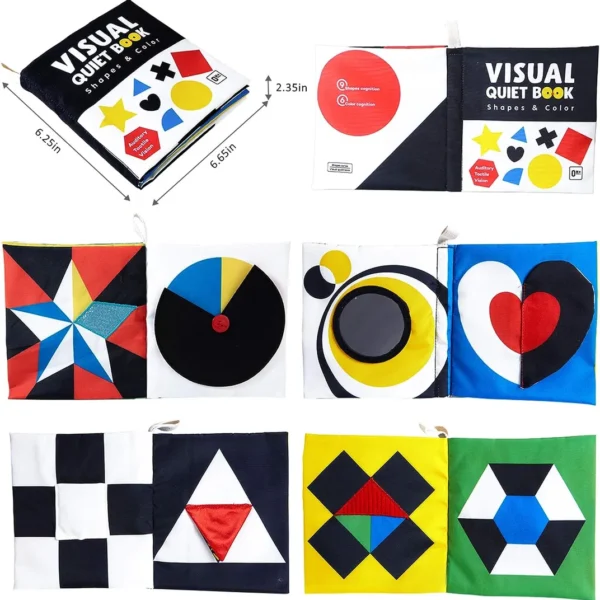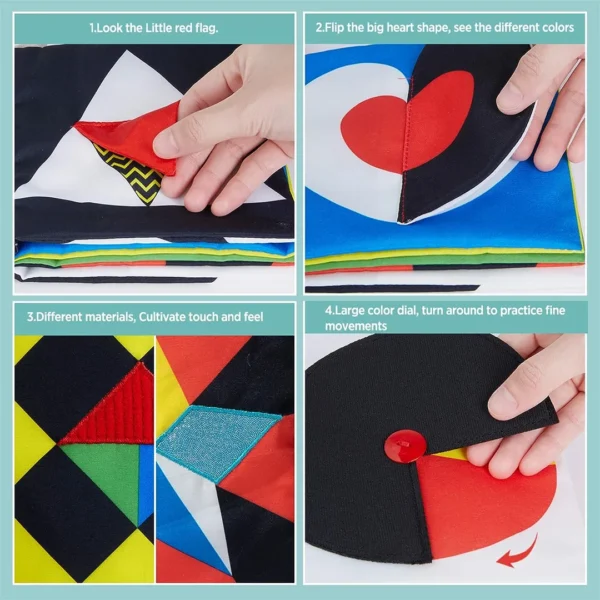Visual Quiet Sensory Book
See, Touch, Learn: The Visual Quiet Book Experience
Boost Your Baby's Brainpower in Just Minutes a Day!
Visual Quiet Sensory Book: Our Expert Review
High-Contrast Colors for Visual Stimulation
The high-contrast colors are a stroke of genius, capturing the essence of Montessori principles by stimulating the infant’s natural curiosity and aiding in the development of the retina and optic nerve. This is not just a book; it’s a visual training ground for your little one.


Interactive Elements for Multi-Sensory Engagement
The interactive features are where this book truly shines. Crinkle paper and bibi sounders are seamlessly integrated, inviting the child to explore and engage. These elements not only entertain but also serve a higher purpose: they activate multiple senses, fostering holistic development in a way that subtly echoes Montessori methods.
Safety and Durability
When it comes to baby products, safety is non-negotiable. This book delivers on that front with its non-toxic, hand-washable materials and robust stitching. It’s a product designed not just to entertain but to endure, aligning with the Montessori value of creating long-lasting, sustainable learning materials.

Conclusion
In summary, the Beiens Visual Quiet Book is a multi-faceted gem that offers a rich, Montessori-infused learning experience. Its high-contrast colors, interactive elements, and focus on safety make it an invaluable addition to your child's early learning journey. This is not just a book; it's an investment in your child's developmental future. Ready to take the next step in your child's early education? Click here to purchase the Beiens Visual Quiet Book on Amazon.
Customer reviews
4.8 out of 5
By feature
Cute little book
Good for baby, could be better
Hard to wash
Not “quiet”
Not interested
Frequently asked questions.
What is the Purpose of a Sensory Book?
Sensory books are designed to engage multiple senses, stimulating cognitive and sensory development in young children. They offer tactile, visual, and sometimes auditory experiences, making them a multi-faceted educational tool.
Why are Touch and Feel Books Important for Early Development?
Touch and feel books are crucial for sensory development in infants and toddlers. They help in building fine motor skills, enhancing hand-eye coordination, and even in the early stages of language acquisition. These interactive elements make them a staple in early childhood education.
How Does a Book Align with Montessori Principles?
Sensory books are designed to engage multiple senses, stimulating cognitive and sensory development in young children. They offer tactile, visual, and sometimes auditory experiences, making them a multi-faceted educational tool.
What Exactly is a Touch and Feel Book?
A touch and feel book incorporates various textures and materials into its pages to stimulate a child’s sense of touch. These books offer a tactile experience that complements the visual elements, making reading a multi-sensory activity.
At What Age are These Books Most Suitable?
These books are generally suitable for children aged 0-12 months but can be beneficial for kids up to 3 years old. They are designed to grow with your child, adapting to their changing interests and developmental stages.
What's the Difference Between Touch and Feel?
“Touch” usually refers to the act of coming into physical contact with different textures in the book, while “feel” refers to the sensory or emotional experience that arises from this interaction. Both are key to the learning experience these books offer.
How Do Feel and Sense Differ?
“Feel” pertains to the tactile or emotional experience a child gets from interacting with the book. “Sense” is a broader term that includes all sensory experiences, such as sight and touch, which these books aim to engage.
What Benefits Does the Sense of Touch Offer?
The sense of touch is crucial for various aspects of development, including fine motor skills, emotional bonding, and cognitive abilities. It’s a foundational sense that supports overall growth and learning.
What Senses are Engaged in Touch and Feel Books?
While these books primarily focus on the sense of touch through various textures, they also engage the sense of sight through colorful and contrasting visuals. Some may even include crinkle or squeaker elements for auditory stimulation.
Why is the Sense of Touch Important to Child Development?
The sense of touch plays a vital role in a child’s emotional and cognitive development. It’s one of the first senses to develop and serves as a fundamental channel for learning and exploration.





